Publication
Article
Pharmacy Times
The Pharmacist's Role in Breaking the Cycle of PMDD
Behavioral Objectives
After completing this continuing education article, the pharmacist should be able to:
1. Describe the etiology, prevalence, and risk factors of premenstrual dysphoric disorder (PMDD).
2. Differentiate the symptoms of PMDD and premenstrual syndrome.
3. List the PMDD diagnostic criteria.
4. Explain the burden of PMDD from a societal and economic standpoint.
5. Analyze the pharmacologic and nonpharmacologic treatment options for PMDD.
6. Counsel patients regarding effective management of PMDD.
As many as 90% of women of reproductive age experience at least 1 uncomfortable symptom during their menstrual cycle.1 Symptoms may be limited to mild discomfort but can be sufficiently bothersome to qualify as premenstrual syndrome (PMS). If symptoms are severe enough, they may be classified as premenstrual dysphoric disorder (PMDD), which can compromise not only a woman's quality of life (QoL), but also the ability to function across family, social, and occupational settings.1
The Menstrual CycleThe female menstrual cycle is comprised of 2 major phases influenced by hormones from the hypothalamus, pituitary, and ovaries (Figure 1).2 These 2 phases are the follicular phase and the luteal phase, with ovulation occurring between the phases. The follicular phase begins on the first day of menses and continues until ovulation. The luteal phase starts from ovulation and ends at the start of the next menses.3
The hypothalamus secretes gonado-tropin-releasing hormone (GnRH), and in response to GnRH the anterior pituitary secretes 2 hormones, follicle-stimulating hormone (FSH) and luteinizing hormone (LH). Days 1 through 4 of the menstrual cycle are marked with an elevation in FSH. This rise in FSH continues the further growth and development of a group of follicles, and 1 follicle becomes dominant during days 5 through 7. This follicle, which secretes estradiol and inhibin, will eventually release an oocyte during the cycle. Estradiol and inhibin act via negative feedback on the hypothalamus and pituitary to reduce FSH levels, which will cease the development of the remaining follicles. As the dominant follicle continues to develop, estradiol levels will continue to increase, leading to the development of the endometrial lining. As estradiol levels remain elevated for a sustained period, the pituitary releases a surge of LH, which causes the final maturation of the dominant follicle, ovulation, and the formation of the corpus luteum. Ovulation generally occurs 34 to 36 hours after the onset of the LH surge.3
The corpus luteum is the main hormone-secreting entity during the luteal phase. After the LH surge, the corpus luteum is stimulated to synthesize and secrete progesterone. Progesterone maintains the endometrial lining for implantation and provides negative feedback on GnRH, FSH, and LH. Reduction of these hormones prevents further development of follicles. If implantation does not occur, the corpus luteum will degenerate and decrease progesterone levels, leading to the shedding of the endometrium and the beginning of a new cycle. At the end of the luteal phase, FSH levels will rise again due to the lack of feedback inhibition. If implantation of an embryo does occur, human chorionic gonadotropin is produced and released by the placenta, which prevents the degeneration of the corpus luteum and maintains progesterone and estrogen levels. The maintenance of progesterone and estrogen levels prevents further development of follicles.3
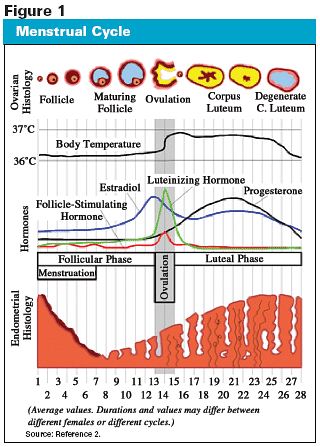
PMS Versus PMDDThe high prevalence of premenstrual disorders and their negative impact on a woman's QoL has been an ongoing concern for both patients and physicians. Because symptoms are so varied and no specific diagnostic test exists, premenstrual disorders are often unrecognized or may be misdiagnosed. Some data have suggested that women seek assistance from an average of 3.75 physicians over an average period of 5.33 years before receiving a diagnosis of PMS or PMDD.1 Diagnostic criteria developed for PMS and PMDD, however, have made it possible to consider more objectively the somatic, emotional, and behavioral symptoms that cause long-term distress for so many women.1
Although most women report some somatic and/or affective symptoms during their menstrual cycle, the character, nature, and extent of these complaints differ greatly, and for many women the symptoms do not recur during each cycle, providing insufficient evidence for a diagnosis. Premenstrual symptoms are characterized by their type, severity, frequency, and timing during the menstrual cycle. Normal manageable symptoms associated with premenstrual molimina (the periodic symptoms such as tension or discomfort that are associated with the physiologic stress preceding or accompanying menstruation) that most ovulatory women experience include breast tenderness, food cravings, and bloating or pelvic heaviness. These symptoms do not typically affect a woman's ability to function during daily activities.1 Both PMS and PMDD are associated with disturbing, predictable, recurring, cyclic symptoms that begin in the late luteal phase of the menstrual cycle and remit shortly after the onset of menstruation. Common somatic or physical symptoms include headache, breast tenderness, and abdominal bloating. Affective or mental/emotional symptoms include irritability, depression, angry outbursts, anxiety, and social withdrawal. PMDD is distinguished from PMS by the severity of symptoms, predominance of affective versus somatic symptoms, and a marked impairment in personal and/or social relationships, including feelings of hopelessness, self-deprecation, and increased interpersonal conflicts.1,4,5 PMDD represents the most severe and disabling end of the spectrum of premenstrual disorders and requires clear evidence of disability to diagnose.4
As many as 40% of women believe they have symptoms sufficiently bothersome to qualify as PMS.1 The American College of Obstetricians and Gynecologists (ACOG) guidelines (Table 1) specify that, to diagnose PMS, 1 or more affective or somatic symptoms must occur during the 5 days before menses in each of the previous 3 menstrual cycles, be relieved within 4 days of the onset of menses, and not recur until at least day 13 of the next cycle.1,6 Diagnosis typically involves the daily charting of symptoms over 2 or more cycles. The most commonly reported symptom associated with PMS is irritability.1
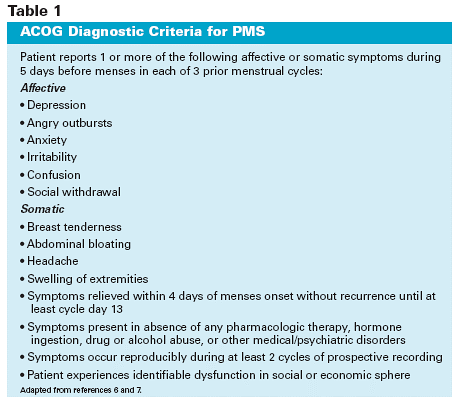
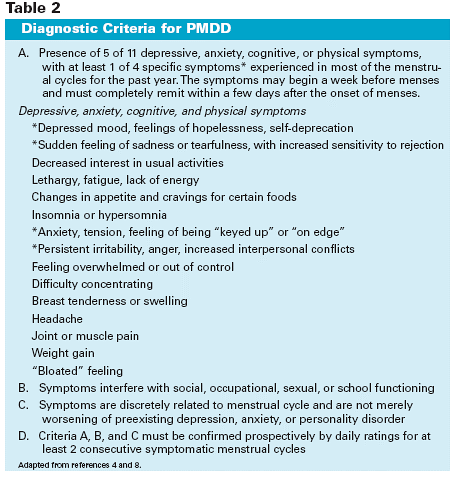
Diagnosing PMDDPMDD, on the other hand, is diagnosed similarly to depression based on the Diagnostic and Statistical Manual of Mental Disorders, Fourth Edition (DSM-IV)8 criteria and requires that at least 5 of the listed symptoms, including 1 of the specific symptoms listed in Table 2, be present during a majority of menstrual cycles during the preceding year (Table 2). Additionally, symptoms must seriously interfere with work, social activities, and personal relationships. PMDD reportedly affects between 2% and 10% of women during their reproductive years, regardless of race or culture.1,4,8-10 PMDD symptoms can begin any time after menarche, but they commonly start to affect women in their early-to-mid 20s. PMDD is a chronic condition that worsens over time until the woman reaches menopause, although symptoms do disappear during pregnancy.
Consensus on the exact cause of PMDD is currently lacking, but it appears to be related to an abnormal response of central neurotransmitters such as serotonin and gamma-aminobutyric acid (GABA) to normal ovarian function, because there has been no demonstrable hormonal imbalance in women with severe PMS or PMDD.5,11 It is hypothesized that women who develop PMDD have an underlying vulnerability in central nervous system (CNS) neurotransmitter systems, especially the serotonergic system. This underlying dysregulation of the serotonergic system is made worse during the luteal phase by the changes in the gonadal steroid levels.11 Biological, psychological, environmental, and social factors all seem to play a role in the disorder. Genetic factors are also pertinent, as 70% of women whose mothers have been affected by PMS have PMS themselves, compared with 37% of women whose mothers have not been affected.10 A large number of women with PMDD also have a history of major depression, anxiety disorders, personality disorders, and/or substance abuse. PMDD is also more common in women with fewer pregnancies and increases in incidence after major life events and stressors.10,11
As part of the diagnosis, PMDD must be distinguished from a premenstrual exacerbation of an underlying depressive and/or anxiety disorder. A diagnostic sign of PMDD is the notable difference in the frequency of moderate-to-severe symptoms during the follicular phase, as compared with the luteal phase of the menstrual cycle, whereas other depressive disorders occur throughout the cycle.1,4
Burden of Disease
PMDD can result in significant interference in a woman's life, including family, social, and work life. A relationship has been found between PMDD symptoms and the social and occupational impairments that women with PMDD experience. As the number of symptoms experienced increases, so does the level to which they impact daily life. PMDD significantly decreases a woman's QoL by an average of 6.4 days of severe symptoms per cycle, adding up to a lifetime total of potentially 3000 days or close to 8 years of impaired functioning during a woman's reproductive years.1
A study conducted by Halbreich et al found that, during the late luteal phase of the menstrual cycle, women with PMDD suffer impairment in their marital and parental relationships that are as severe as women with other repeated or chronic clinical depressions; additionally, they have social- and leisure-activity impairment that is even worse, resulting in a substantially impaired QoL.9 Similarly, Rapaport et al concluded that the magnitude of disruption caused by PMDD on women is comparable with that of other depressive or anxiety disorders, and mean scores on QoL, enjoyment, and satisfaction questionnaires are similar to those of dysthymia (Figure 2).12

Societal and Economic Impact
PMDD can have both direct and indirect economic costs. The direct costs include outpatient office visits, laboratory costs, and costs for treatments. The indirect costs are more difficult to quantify and include lost productivity due to missed days of work or impairment from symptoms while at work, as well as lost wages from the days taken off due to PMDD symptoms.1
A study by Chawla et al was conducted to quantify the economic burden of PMDD by assessing health care service use and related expenditures, work loss, role limitation, and productivity. The study concluded that, although the use of health care services such as emergency department visits increases as symptom severity increases, the economic burden of PMDD manifests primarily in reported productivity decreases while at work or reduced hours worked per day.13
Borenstein et al developed a model to project direct and indirect costs related to PMS and concluded that a PMS diagnosis was associated with an average annual increase of more than $4000 in indirect costs as a result of a 15% reduction in productivity due to absenteeism and reduced efficiency while at work. This was similar to productivity losses due to other major diseases, such as gastrointestinal (GI) reflux disease, headaches, and back pain.14 Additionally, Borenstein notes in a separate study that women with PMS used more health care resources than those without PMS in terms of increased frequency of ambulatory care visits and in the proportion of individuals that accrue >$500 in visit costs over 2 years.15
Pharmacologic Treatments for PMDD
Initiation of therapeutic intervention begins once the patient meets the DSM-IV diagnostic criteria for PMDD. There are many different treatment options available for PMDD ranging from the basic lifestyle modifications and nonpharmacologic interventions, to nutritional supplements, herbal supplements, pharmacologic interventions, and surgery. Treatment strategies need to be individualized based on specific patient desires and needs to obtain the required effectiveness (Table 3). Goals for treating PMDD are to provide patients with the following10:
- Symptom reduction
- Improvement in social and occupational functioning
- Overall enhancement in QoL
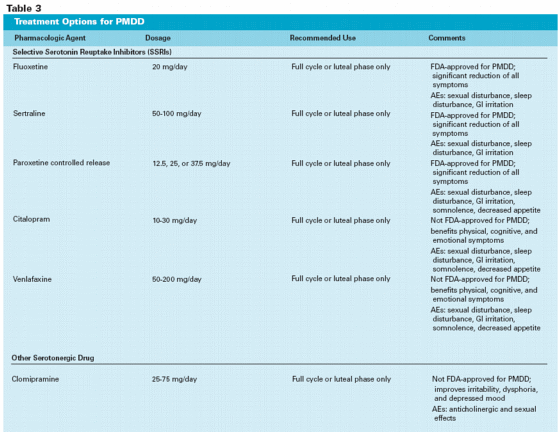
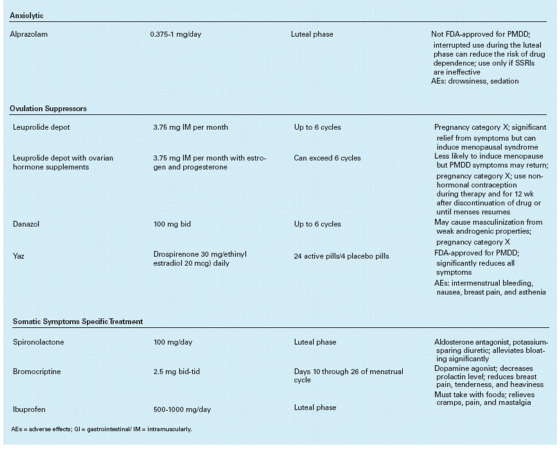
Although no single intervention has proved effective for all patients with PMDD, a wide range of agents have been used for the management of PMS/PMDD that have targeted various aspects of the perceived underlying pathophysiology of the condition. Primarily, 2 general categories of agents are used for the treatment of PMS/PMDD: one involves suppression of the ovulation process and the other targets CNS processes that are thought to contribute to mood symptoms.11,19
Affective Symptom Improvement
Affective symptoms, such as irritability, depression, angry outbursts, and anxiety, experienced by women with PMDD appear to be related to changes in neurotransmitters such as serotonin and GABA caused by ovulation and normal gonadal hormone release.1 Treatment of these emotional symptoms associated with PMDD have therefore been primarily directed toward the use of agents that impact these neurotransmitters.
Selective Serotonin Reuptake Inhibitors (SSRIs). SSRIs were the first FDA-approved treatments for PMDD and are considered to be the first line of therapy. Many studies have shown that SSRIs improve symptoms of irritability, depressed mood, and dysphoria and enhance work performance and overall QoL in patients with PMDD.5,10,16,17 Currently, 3 SSRIs have been approved by the FDA for the treatment of PMDD: fluoxetine (Sarafem), sertraline, and paroxetine controlled release.
Although SSRIs offer the potential for controlling affective symptoms, they do not come without side effects. Use of SSRIs may lead to adverse events including sexual dysfunction, insomnia, fatigue, weight gain, and nervousness. Numerous drug interactions with SSRI agents can also pose a problem for patients taking other agents that are highly protein-bound or metabolized through the cytochrome P-450 pathway, such as barbiturates, benzodiazepines, digoxin, warfarin, and theophylline.18
SSRI therapy can be initiated as continuous, intermittent, and/or semi-intermittent dosing. Continuous dosing involves administering the SSRI once a day during the entire menstrual cycle. Women with coexisting mood or anxiety disorders and those who develop mood symptoms during the follicular phase could benefit from continuous dosing. Other candidates for continuous dosing include those who have trouble remembering the timing of intermittent dosing, those who have irregular menstrual cycles, and those who are concerned about symptoms from abrupt discontinuation of an SSRI.5 Additionally, some data suggest that continuous dosing of SSRIs may have an impact on somatic symptoms associated with PMDD, whereas intermittent therapy has been shown to have little effect on somatic complaints.19
In intermittent or luteal-phase dosing, treatment begins at the same time as ovulation and stops 1 or 2 days after menses begins.5 Women with regular menstrual cycles who are able and willing to adhere to this on/off schedule and have no symptoms during the follicular phase are good candidates for this type of treatment. The semi-intermittent dosing is more complicated, involving continuous administration of the SSRI throughout the cycle with increased doses during the luteal phase.5 Additionally, other agents such as citalopram (another SSRI) and venlafaxine (a serotonin and norepinephrine re-uptake inhibitor), have also been studied and used in the treatment of PMDD, but they are not FDA-approved for this purpose.
GABAergic Agents. Although not FDA-approved for the treatment of PMDD, alprazolam has been studied and used to treat PMDD symptoms during the luteal phase of the menstrual cycle. Some studies have shown that alprazolam reduces the symptoms of depression, anxiety, irritability, low mood, mood lability, impulsivity, fatigue, social withdrawal, and impaired social functioning experienced by women with PMDD but does not impact the physical or somatic symptoms.19
Side effects and addictive potential limit the usefulness of this agent as a chronic therapy, however.19,20
Somatic Symptom Improvement
Physical symptoms such as mastalgia (pain/tenderness in the breast), cramps, bloating, abdominal pain, and headache are typically treated with specific symptom relief therapies.
Analgesics. Nonsteroidal anti-inflammatory drugs (NSAIDs) such as ibuprofen and naproxen can be used to relieve somatic pain and cramps during the luteal phase of the menstrual cycle. NSAIDs should not be taken with any other aspirin or aspirin-containing products and should always be taken with food to prevent GI upset and/or bleeding. These agents have no impact on other PMDD symptoms, however, making their use limited to adjunctive therapy.
Diuretics. The use of spironolactone, a potassium-sparing aldosterone-receptor antagonist, to reduce symptoms related to water retention is inconclusive. Spironolactone has been shown in some studies to improve symptoms of general bloating in doses of 100 mg per day when taken on day 12 of the cycle until menses or from days 19 through 26 of the cycle.19
Other symptoms, however, including depression, sadness, lethargy, anxiety, headache, breast tenderness, swollen abdomen, and swollen feet did not significantly improve with spironolactone therapy. Common side effects of spironolactone can include drowsiness, lethargy, headache, nausea, and/or cramping. In addition, because spironolactone is a potassium-sparing diuretic, women using this agent need to be counseled regarding potassium intake and asked to notify their physician if they develop signs of muscle weakness, fatigue, or muscle cramping.
Patients should be cautioned about the increased risk of hyperkalemia (increased potassium levels) if they are taking both spironolactone and other potassium-sparing agents such as an angiotensin-converting enzyme (ACE) inhibitor, aldosterone antagonist, or angiotensin II-receptor antagonist.
Dopamine Agonists. Breast pain and tenderness, usually associated with breast swelling, occur in many women during the late luteal phase. Bromocriptine, a dopamine agonist, has been shown to reduce prolactin levels believed to be associated with these symptoms when given during the luteal phase of the menstrual cycle. Little evidence suggests that the use of bromocriptine alleviates any non-breast-related symptoms associated with PMS or PMDD, however, and common side effects of dizziness and nausea limit its use in some patients.11,19
Relief of Both Affective and Somatic SymptomsEstrogen/progesterone Combinations. Recently, Yaz (drospirenone 3 mg/ethinyl estradiol 20 mcg) was the first oral contraceptive approved by the FDA for the treatment of PMDD. Drospirenone, the progesterone component of Yaz, is an analog of spironolactone with diuretic activity that has shown to lessen premenstrual bloating, breast pain, depression, and irritability. Yaz has shown to be clinically effective in treating both the emotional and physical symptoms of PMDD.21 With its unique progesterone and low-dose estrogen formulation along with a shortened drug-free interval (24 active/4 placebo pill pack), studies have shown a >50% reduction in daily symptoms scores in 48% of patients taking Yaz, compared with only 36% of patients taking placebo.22 Recent meta-analyses have also reported that the general therapeutic effect of Yaz is similar to that of SSRIs, except that Yaz demonstrates a greater reduction in physical symptoms, compared with SSRIs.22 Common side effects observed during clinical trials were inter-menstrual bleeding, nausea, breast pain, and asthenia.22,23
Additionally, because the progesterone in Yaz, drosperonone, is a spironolactone analog, women using Yaz need to be counseled regarding potassium intake and to notify their physician if they develop signs of muscle weakness, fatigue, or muscle cramping. Patients should be cautioned about the increased risk of hyperkalemia (increased potassium levels) if they are taking both Yaz and other potassium-sparing agents such as a potassium-sparing diuretic, ACE inhibitor, aldosterone antagonist, or angiotensin II receptor antagonist.
Ovulation Suppressants. Data support that cyclical fluctuations of ovarian hormones are associated with PMDD symptoms; thus, ovulation-suppressing therapies have been thought to be a useful therapeutic option for treating symptoms. GnRH agonists such as leuprolide, and androgens such as danazol have both been shown effective in reducing the symptoms of PMDD, especially irritability, breast tenderness, fatigue, and bloating. The cost of these agents, however, along with potential hypoestrogenic side effects, such as osteoporosis, masculinization, and atrophic vaginitis, limit their use to only the most severe patients who cannot be managed through other therapies.10,19,20
Nonpharmacologic Management and Other Treatment Options
Nonpharmacologic interventions for PMS and PMDD include patient education, supportive therapies, and behavioral changes. Women who have been educated about the biologic basis and prevalence of PMS symptoms report a sense of control and symptom relief.20
Behavioral measures may include keeping a diary of symptoms (Figure 3), getting adequate rest and exercise, and making dietary changes such as reducing the intake of salt, alcohol, and caffeine, which help to minimize fluid retention and insomnia.20
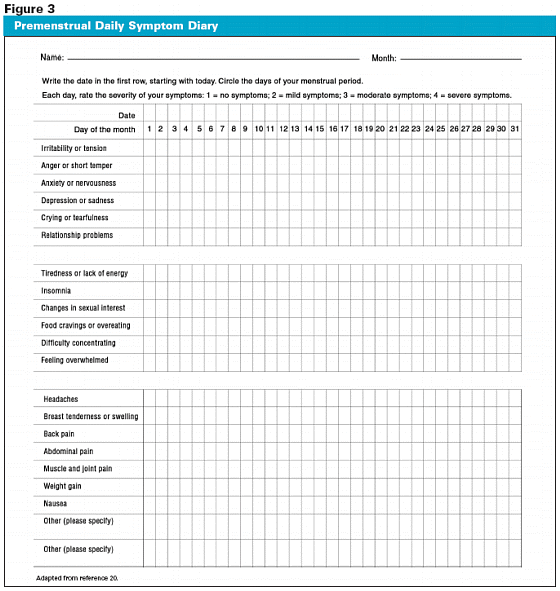
Vitamins and dietary supplements such as calcium, magnesium, and vitamins A, E, and B6 have also been shown in some studies to improve PMS and PMDD symptoms, although the evidence is best with calcium supplementation and vitamin E.20,24,25 Vitamin E in doses of 400 IU per day during the luteal phase has been shown to improve affective and somatic symptoms in women with PMS.20 Similarly, calcium carbonate in doses of 1200 mg per day for 3 menstrual cycles resulted in symptom improvement in 48% of women, compared with 30% of women taking placebo.20
Many women also turn to botanicals for relief of PMS and PMDD symptoms. Several agents, including chasteberry, evening primrose oil, black cohash, ginkgo, St. John's wort, kava, and others have been considered potential therapies. 11 In addition, acupressure, acupuncture, massage therapy, reflexology, and light therapy have been explored as potential nonpharmacologic treatments for PMS and PMDD.11 Although some of these therapies showed promise in early evaluations, large randomized, placebo-controlled studies need to be conducted to determine the value of these therapies in the treatment of PMS or PMDD.11,25
Role of the Pharmacist in Patient ManagementWhile seeking ways to manage their symptoms, many women may turn to their pharmacist for information on how best to manage premenstrual complaints prior to consulting with their physician or other health care provider. Thus, the pharmacist has the opportunity to offer support and guidance to these women on how to successfully manage both the physical and emotional symptoms of PMS or PMDD that are having a significant impact on their lives. Counseling women on the nature of their symptoms and the variety of treatment options can provide much needed reassurance as well as encouragement to seek additional assistance and appropriate treatment.
Key counseling points the pharmacist can touch on are as follows11,26:
- Know that many women have premenstrual symptoms-the patient is not alone
- Keep a daily record/calendar of symptoms for at least 2 cycles to determine if there is a pattern in symptoms (Figure 3)
- Reduce added salt, caffeine, and alcohol to help relieve symptoms associated with water retention and insomnia
- Participate in regular exercise and try relaxation techniques to help reduce stress levels, which may help reduce emotional symptoms
- Encourage the use of OTC pain relievers as needed to help with dysmenorrhea and breast pain
- Caution against trying unproven herbal remedies, and instead encourage good nutrition and regular vitamin supplements that include calcium and vitamin E
- Encourage the patient to discuss her symptoms with her physician, who may be able to recommend other prescription medication(s) based on the primary symptoms
- Explain that several prescription therapies are available and that therapy can be tailored to her specific preferences and needs
- Provide a basic explanation of the menstrual cycle and how symptoms occur cyclically to help alleviate fears and concerns and impart a sense of control
Summary
Somatic and/or affective symptoms during the menstrual cycle are common complaints for most women. Both PMS and PMDD are associated with disturbing, predictable, recurring, cyclic symptoms that begin in the late luteal phase of the menstrual cycle and remit shortly after the onset of menstruation. PMDD represents the more severe and disabling end of the spectrum of premenstrual disorder and requires clear evidence of disability to diagnose.
SSRIs are considered to be first-line treatment, but with the recent FDA approval of Yaz, women now have more options in managing their PMDD symptoms, especially those who desire contraception in addition to PMDD symptom relief. In addition to drug therapy, nonpharmacologic therapies such as diet modification and exercise, and supplementation with vitamin E and calcium seem to be of benefit.
Pharmacists can play a significant role in providing women with education about the biologic basis of the disease and the prevalence of PMS symptoms, along with advice on available prescription, nonprescription, and nonpharmacologic therapies to help improve patients' sense of control and help them obtain symptom relief.20
For additional information on PMS and PMDD, pharmacists can refer to the following organizations:
- American College of Obstetricians and Gynecologists; 800-762-2264; www.acog.org
- National Institute of Mental Health; 866-615-NIMH (6464); www.nimh.nih.gov
- Hormone Foundation; 800-467-6663; www.hormone.org
(Based on the article starting on page 116) Choose the 1 most correct answer.
1. What is the cause of premenstrual dysphoric disorder (PMDD)?
- Abnormal levels of ovarian hormones
- Pregnancy
- Abnormal monthly menstrual cycle
- Cause is unknown
2. Symptoms of PMDD are known to become worse during pregnancy.
- True
- False
3. How can one differentiate PMDD from premenstrual syndrome (PMS)?
- Women with PMDD have a predominance of emotional symptoms and a marked dysfunction in personal relationships.
- Women with PMDD have a higher frequency of moderate symptoms in the follicular phase, compared with the luteal phase.
- PMDD symptoms last longer during the cycle than PMS symptoms.
- PMS symptoms last longer during the cycle than PMDD symptoms.
4. To diagnose PMDD, the following must be established:
- Symptoms must interfere with social, occupational, sexual, or school function.
- Symptoms need to meet Diagnostic and Statistical Manual of Mental Disorders, Fourth Edition, diagnostic criteria.
- The symptoms must not be an exacerbation of an underlying depressive, anxiety, or personality disorder.
- All of the above
5. The following is not a specific symptom that needs to be identified for diagnosis of PMDD:
- Depressed mood and feeling of hopelessness
- Sudden feeling of sadness or tearfulness with increased sensitivity to rejection
- Difficulty remembering
- Persistent irritability, anger, increased interpersonal conflicts
6. The magnitude of disruption in the quality of life of women with PMDD is comparable to which of the following disorder(s)?
- Major depression
- Dysthymia
- Anxiety disorders
- All of the above
7. The treatment goals for PMDD patients include the following:
- Symptom reduction
- Improvement in social and occupational functioning
- Overall enhancement in quality of life
- All of the above
8. Which of the following is an appropriate behavioral modification for PMDD?
- Intense exercise
- Weight loss
- Reducing salt and alcohol intake
- All of the above
9. The economic burden of PMDD is primarily due to:
- Increased hospitalizations
- Drug costs
- Decreased productivity
- None of the above
10. The following nonpharmacologic therapy will not help alleviate PMDD symptoms:
- Vitamin B6
- Vitamin C
- Vitamin E
- Calcium
11. Which of the following is/are pharmacologic options for treating PMDD?
- Selective serotonin reuptake inhibitors (SSRIs)
- Muscle relaxants
- Antipsychotic agents
- All of the above
12. Which of the following is/are FDA-approved medications for PMDD?
- Sarafem, citalopram, paroxetine controlled release, and Yaz
- Sarafem, sertraline, paroxetine controlled release, and Yaz
- Fluoxetine, Wellbutrin, venlafaxine, and Yaz
- Paroxetine, fluvoxamine, Sarafem, and Yaz
13. What is the first-line treatment for PMDD?
- Oral contraceptives
- SSRIs
- Nonsteroidal anti-inflammatory drugs
- Gonadotropin-releasing hormone agonists
14. Intermittent dosing is giving the SSRI once daily starting at ovulation and stopping 1 to 2 days after menses begins.
- True
- False
15. The following is not a direct cost for treating PMDD:
- Outpatient physician office visits
- Lost wages
- Drug costs
- Emergency department visits
16. SSRIs are only effective in treating the physical symptoms of PMDD.
- True
- False
17. Which of the following medications is effective in treating both the physical and emotional symptoms of PMDD?
- Bromocriptine
- Yaz
- Sarafem
- Alprazolam
18. Which of the following shows the correct association between medications and symptom relief in treating PMS/PMDD?
- Ibuprofen ? somatic pain and cramping
- Spironolactone ? bloating
- Bromocriptine ? mastalgia and depression
- A and B
19. Pharmacists can assist patients with PMS/PMDD by:
- Providing education on the biologic basis of the disease
- Providing information on the prevalence of symptoms
- Suggesting methods to minimize fluid retention
- All of the above
20. Which of the following herbal therapies should be recommended to patients with PMDD?
- Kava
- Ginkgo
- Chasteberry
- None of the above
Please click here to take test
References
1. Mishell D. Premenstrual disorders: epidemiology and disease burden. Am J Manag Care. 2005;11:S473-S479.
2. Wikipedia contributors. Menstrual cycle. Wikipedia, The Free Encyclopedia. April 29, 2007, 09:49 UTC. Available at: http://en.wikipedia.org/w/index.php?title=Menstrual_cycle&oldid=126823676. Accessed March 2007.
3. Lieu C, Yoshida T. Infertility. In: Dipiro J, ed. Pharmacotherapy: A Pathophysiologic Approach. 5th ed. McGraw-Hill Co; 2002:1431-1443.
4. Freeman E, Sondheimer S. Premenstrual dysphoric disorder: recognition and treatment. Prim Care Companion J Clin Psychiatry. 2003;5:30-39.
5. Steiner S, Pearlstein T, Cohen L, et al. Expert guidelines for the treatment of severe PMS, PMDD, and comorbidities: the role of SSRIs. J Womens Health. 2006;15(1):57-69.
6. Milewicz A, Jedrzejuk D. Premenstrual syndrome: From etiology to treatment. Maturitas The European Menopause Journal. 2006;55S:S47-S54.
7. American College of Obstetricians and Gynecologists. Available at: www.acog.com. Accessed March 2007.
8. Premenstrual dysphoric disorder. In: American Psychiatric Association. Diagnostic and Statistical Manual of Mental Disorders, Fourth Edition, Text Revision. Washington, DC: APA; 2000: 771-775.
9. Halbreich U, Borenstein J, Pearlstein T, Kahn L. The prevalence, impairment, impact, and burden of premenstrual dysphoric disorder (PMS/PMDD). Psychoneuroendocrinology. 2003;28(suppl 3):1-23.
10. Bhatia SC, Bhatia SK. Diagnosis and treatment of premenstrual dysphoric disorder. Am Fam Physician. 2002;66(7):1239-1248.
11. Kaur G, Gonsalves L, Thacker H. Premenstrual dysphoric disorder: A review for the treating practitioner. Cleve Clin J Med. 2004;71(4):303-318.
12. Rapaport MH, Clary C, Fayyad R, Endicott J. Quality-of-life impairment in depressive and anxiety disorders. Am J Psychiatry. 2005;162:1171-1178.
13. Chawla C, Swindle R, Long S, Kennedy S, Sternfeld B. Premenstrual dysphoric disorder: is there an economic burden of illness? Med Care. 2002;40(11):1101-1112.
14. Borenstein J, Chiou CF, Dean B, Wong J, Wade S. Estimating direct and indirect costs of premenstrual syndrome. J Occup Environ Med. 2005;47:26-33.
15. Borenstein JE, Dean BB, Endicott J, et al. Health and economic impact of the premenstrual syndrome. J Reprod Med. 2003;48:515-524.
16. Steiner M, Brown E, Trzepacz P, et al. Fluoxetine improves functional work capacity in women with premenstrual dysphoric disorder. Arch Womens Ment Health. 2003;6:71-77.
17. Yonkers KA, Halbreich U, Freeman E, et al. Symptomatic improvement of premenstrual dysphoric disorder with sertraline treatment: a randomized controlled trial. JAMA. 1997;278(12):983-988.
18. Lacy C, Armstrong L, Goldman M, Lance L. Drug Information Handbook. 12th ed. Hudson, OH: Lexi-Comp; 2004.
19. Halbreich U, O'Brien PS, Ericksson E, Backstrom T, Yonkers K, Freeman E. Are there differential symptom profiles that improve in response to different pharmacological treatments of premenstrual syndrome/premenstrual dysphoric disorder? CNS Drugs. 2006;20(7):523-547.
20. Dickerson LM, Mazyck PJ, Hunter MH. Premenstrual syndrome. Am Fam Physician. 2003;67:1743-1752.
21. Press Release: FDA approves new indication for YAZ to treat the emotional and physical symptoms of premenstrual dysphoric disorder (PMDD). Available at: www.YAZ.com. Accessed March 2007.
22. Yonkers KA, Brown C, Pearlstein TB, Foegh M, Sampson-Landers C, Rapkin A. Efficacy of a new low-dose oral contraceptive with drospirenone in premenstrual dysphoric disorder. Obstet Gynecol. 2005;106(3):492-501.
23. Pearlstein T, Bachmann G, Zacur H, Yonkers K. Treatment of premenstrual dysphoric disorder with a new drospirenone-containing oral contraceptive formulation. Contraception. 2005;72:414-421.
24. Bianchi-Demicheli F, Ludicke F, Lucas H, Chardonnens D. Premenstrual dysphoric disorder: current status of treatment.Swiss Med Wkly 2002;132:574-578.
25. Girman A, Lee R, Kligler B. An integrative medicine approach to premenstrual syndrome. Am J Obstet Gynecol. 2003;188(5 suppl):S56-S65.
26. Rapkin AJ. New treatment approaches for premenstrual disorders. Am J Manag Care. 2005;11(16):S480-S491.







